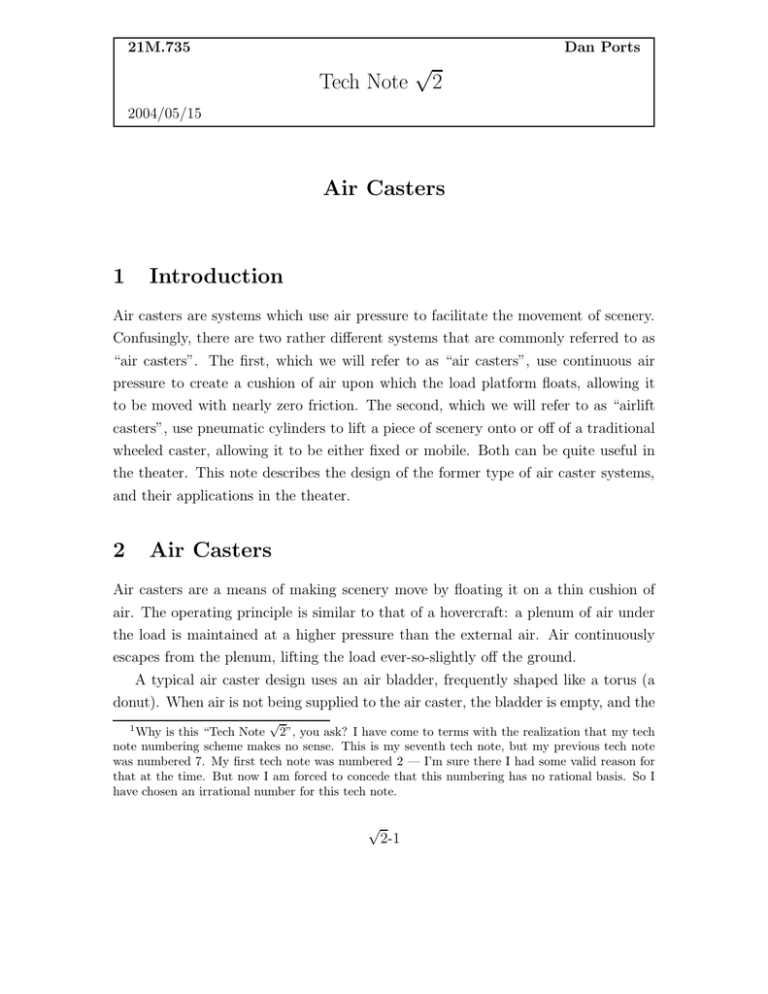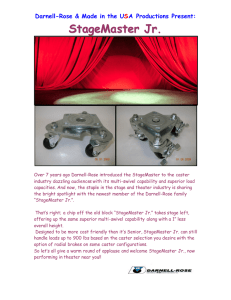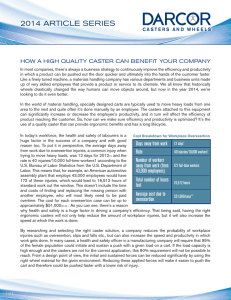Document 13604637
advertisement

21M.735 Dan Ports Tech Note √ 2 2004/05/15 Air Casters 1 Introduction Air casters are systems which use air pressure to facilitate the movement of scenery. Confusingly, there are two rather different systems that are commonly referred to as “air casters”. The first, which we will refer to as “air casters”, use continuous air pressure to create a cushion of air upon which the load platform floats, allowing it to be moved with nearly zero friction. The second, which we will refer to as “airlift casters”, use pneumatic cylinders to lift a piece of scenery onto or off of a traditional wheeled caster, allowing it to be either fixed or mobile. Both can be quite useful in the theater. This note describes the design of the former type of air caster systems, and their applications in the theater. 2 Air Casters Air casters are a means of making scenery move by floating it on a thin cushion of air. The operating principle is similar to that of a hovercraft: a plenum of air under the load is maintained at a higher pressure than the external air. Air continuously escapes from the plenum, lifting the load ever-so-slightly off the ground. A typical air caster design uses an air bladder, frequently shaped like a torus (a donut). When air is not being supplied to the air caster, the bladder is empty, and the √ Why is this “Tech Note 2”, you ask? I have come to terms with the realization that my tech note numbering scheme makes no sense. This is my seventh tech note, but my previous tech note was numbered 7. My first tech note was numbered 2 — I’m sure there I had some valid reason for that at the time. But now I am forced to concede that this numbering has no rational basis. So I have chosen an irrational number for this tech note. 1 √ 2-1 load rests on some other support. Frequently, this is built into the air caster unit, as in Figure 1. Some air casters, however, do not have a built-in air-off support; in this case, it must be built in to the structure of the platform instead. Fortunately, this is not difficult; it can be done by placing a support on the platform or other scenic unit that is either flush with or extends slightly beyond the depth of the uninflated air caster. When air is applied, the bladder inflates and presses against the ground, as in Figure 2. This seals off the area inside the torus. The air pressure is then applied to the plenum inside the torus. Once the plenum reaches a sufficiently high pressure, it can lift the load off the ground, as in Figure 3. A thin layer of air constantly escapes from under the bladder on all edges. The load can be easily moved on this layer of air. Figure 1: Air caster, section view, air off Figure 2: Air caster, section view, air on One of the principal advantages of air casters is that they are able to lift heavy loads with relative ease. A single 12′′ -diameter air caster may have a rated load of 2,000 pounds, and even larger models are available, up to 48′′ air casters rated for lifting 80,000 pound loads (perfect for those really heavy sets). A single air caster, however, cannot be used for lifting; instead, a minimum of three or four air casters √ 2-2 Figure 3: Air caster, section view, floating around the perimeter of the load must be used. The load should be distributed as evenly as possible around the air casters, so that no one bears too much of the load; otherwise, the air may escape from the plenum. Generally it is recommended to place the air casters only around the perimeter of the unit, since this simplifies installation and routing of the air hose, but occasionally for large units it is necessary to have some placed in the interior; this can be done but requires some careful construction. Once the air casters have lifted a load, it can be moved around with surprisingly little force required. Thousands of pounds of load may be moved with only a few pounds of force. The air casters also have the convenient “zero-throw” property: changing direction of movement is not difficult. As is blindingly obvious from the name, air casters operate on air. They require a continuous flow of air while being operated, though usually not at an especially high pressure. A 10,000 pound-capacity caster may consume around 75 CFM of air, supplied at an operating pressure of only 25 psi or so — it is a high-volume but low-pressure device. Larger air casters, of course, will require proportionately larger volumes, and sometimes slightly higher pressures as well. Hence, a low-pressure air blower can usually be used as an alternative to an air compressor. The air blower is cheaper, but requires a larger caster system. Air compressors are more expensive and require a storage tank, but this cost is offset by the fact that they are frequently available in the theater for other purposes: a standard air compressor normally used for powering pneumatic tools or paint sprayers can be used to power air casters. A hose is the typical minimum for supplying the necessary volume of air to a 12′′ 3/4′′ air caster; larger air casters often require hoses in the 1′′ – 11/2′′ range. Noise is always a concern with an air caster system. Compressors and blowers are inherently noisy devices, and hearing one of them operating generally doesn’t √ 2-3 fit too well into a show. Fortunately, they can often be placed offstage, with hoses run to the air casters. It is important to keep the hoses close to the same length, since radically different lengths may cause a pressure differential that can cause one side of the unit to float higher than the other, limiting efficiency. Alternatively, a pressurized air tank could be used to supply the air rather than a compressor. This can be a viable option because the air casters are typically operated only for a short period during a scene change. The air tank will need to be sized accordingly — the flow rate in cubic feet per minute is available from the caster manufacturer, and this is multiplied by the length of time the caster will be pressurized. Even if these solutions are used, however, there will still be some noise from the air escaping from the plenum, especially if used on a rough or non-uniform surface (see below). This is unavoidable and is one disadvantage of air casters. Another concern with air casters is their need for a smooth, non-porous floor surface. This can be a problem in the theater since the average stage may not be suitably smooth, may very well be out of level, and likely has some sort of traps or pockets through which air can flow. These can cause the air to escape from the plenum when they are hit, bringing the movement of the platform to an abrupt halt and requiring it to be forcibly moved to a more suitable surface — not a very desirable situation. The floor can be prepared to make it smooth and tolerable for air casters. This is typically done by applying a surface of vinyl or some other plastic sheeting, or smooth-sided Masonite, with the joints carefully sealed. References [1] W. O. Parker, R. C. Wolf, and D. Block, Scene Design and Stage Lighting, 8th ed., ser. Wadsworth Series in Theatre. Thomson-Wadsworth, 1990. [2] R. L. Arnold, Scene Technology, 2nd ed. Englewood Cliffs: Prentice-Hall, 1990. [3] Stagecraft mailing list archives, http://www.stagecraft.org/. [4] ASE Systems: Air Caster Load-Moving Modules, http://www.asesystems.com/ aircasters.htm. √ 2-4


